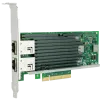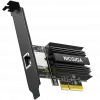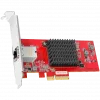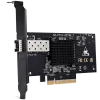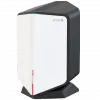10 Gigabit Ethernet (10GE, 10GbE, or 10 GigE) is a group of computer networking technologies for transmitting Ethernet frames at a rate of 10 gigabits per second (10×109 or 10 billion bits per second). It was first defined by the IEEE 802.3ae-2002 standard. Unlike previous Ethernet standards, 10 Gigabit Ethernet defines only full duplex point-to-point links which are generally connected by network switches; shared-medium CSMA/CD operation has not been carried over from the previous generations Ethernet standards. Half duplex operation and hubs do not exist in 10GbE.
Like previous versions of Ethernet, 10GbE can use either copper or fiber cabling. However, because of its bandwidth requirements, higher-grade copper cables are required: category 6a or Class F/Category 7 cables for links up to 100m. The 10 Gigabit Ethernet standard encompasses a number of different physical layer (PHY) standards. A networking device, such as a switch or a network interface controller may have different PHY types through pluggable PHY modules, such as those based on SFP+. At the time that the 10 Gigabit Ethernet standard was developed, interest in 10GbE as a wide area network (WAN) transport led to the introduction of a WAN PHY for 10GbE. The WAN PHY encapsulates Ethernet packets in SONET OC-192c frames and operates at a slightly slower data-rate (9.95328 Gbit/s) than the local area network (LAN) PHY.
